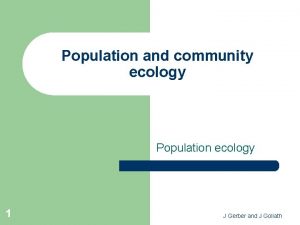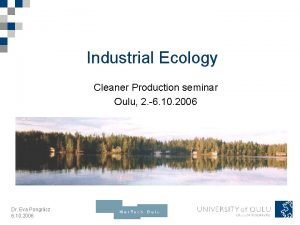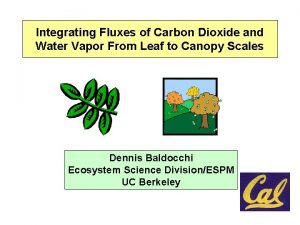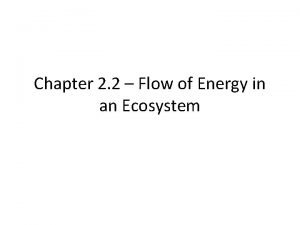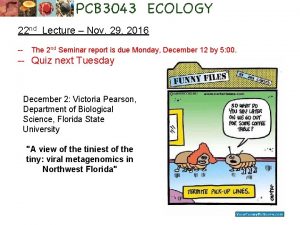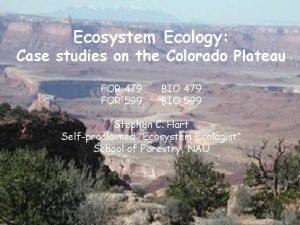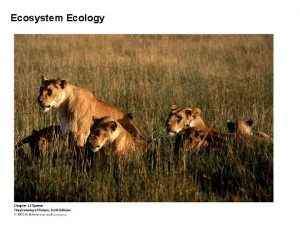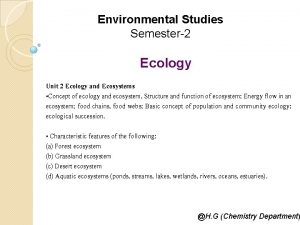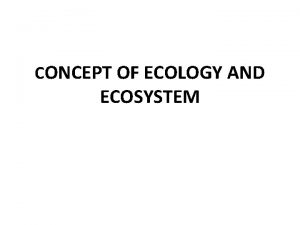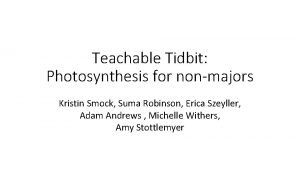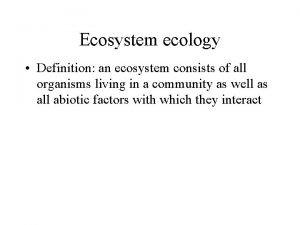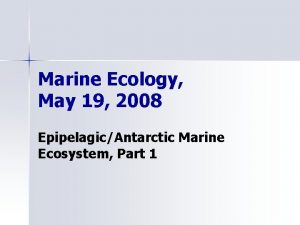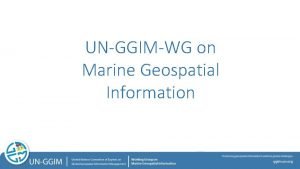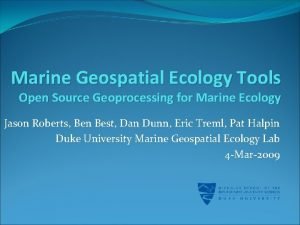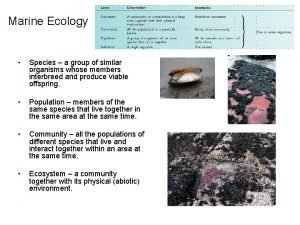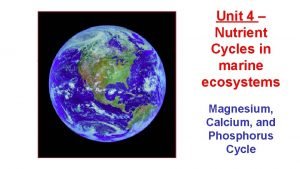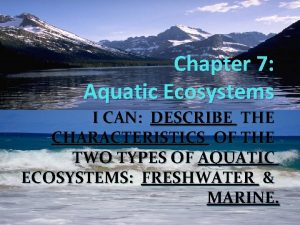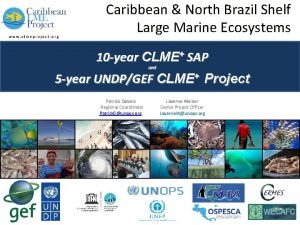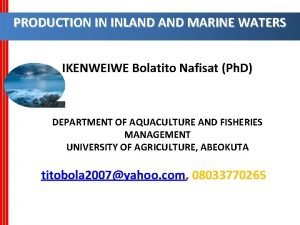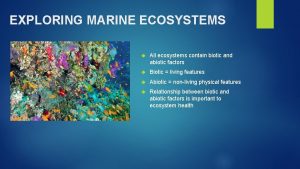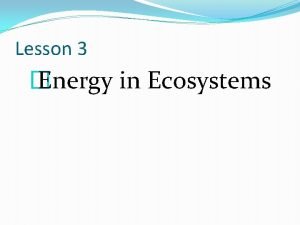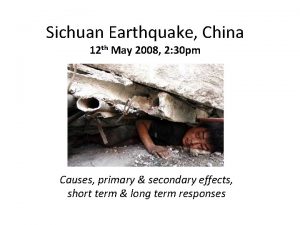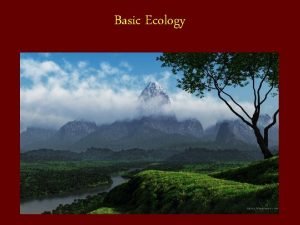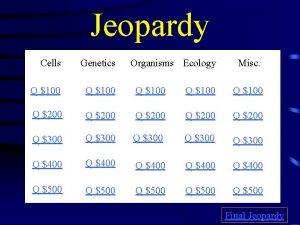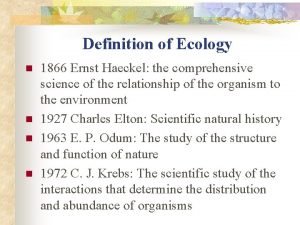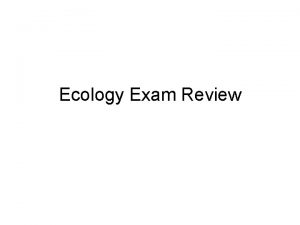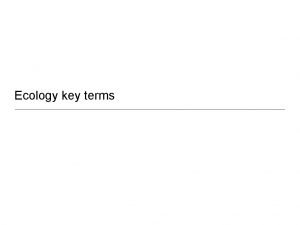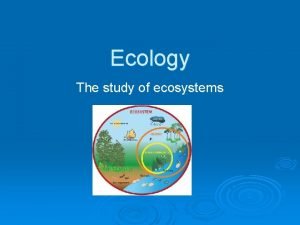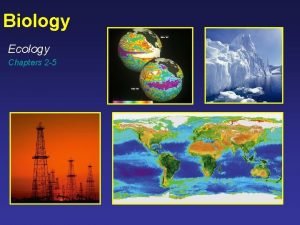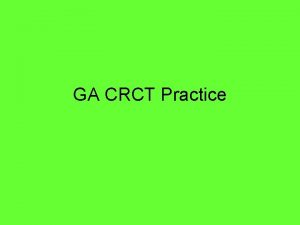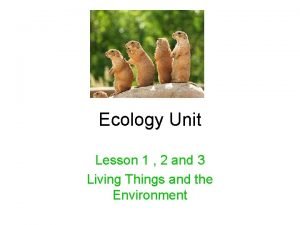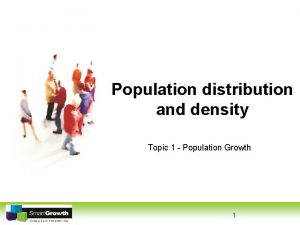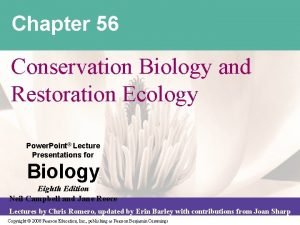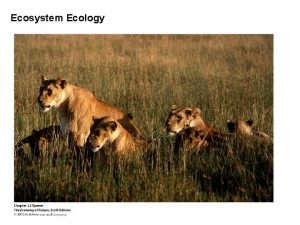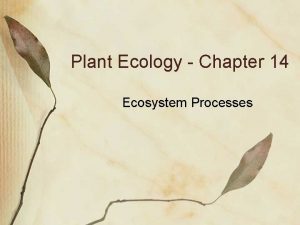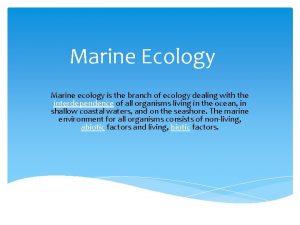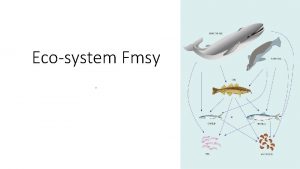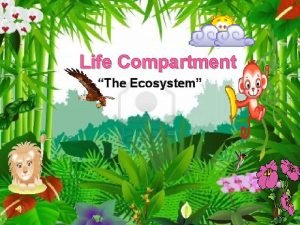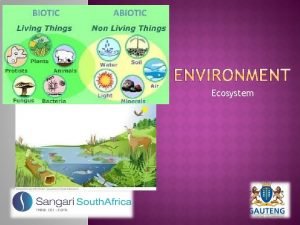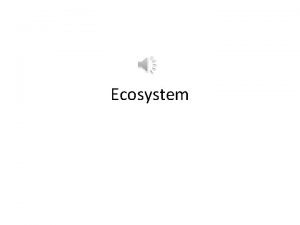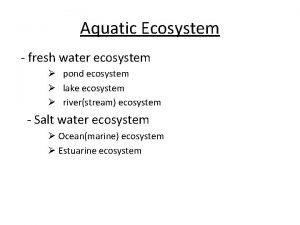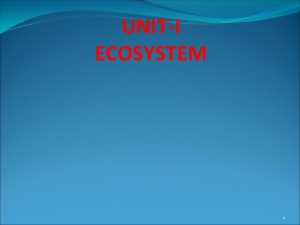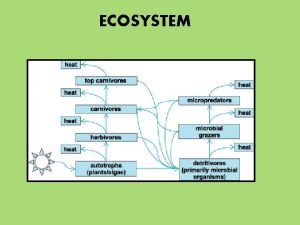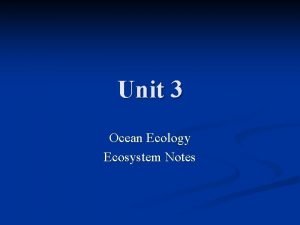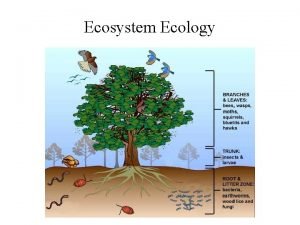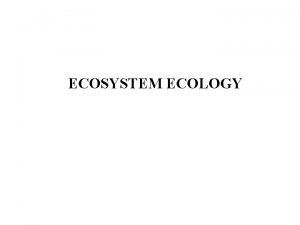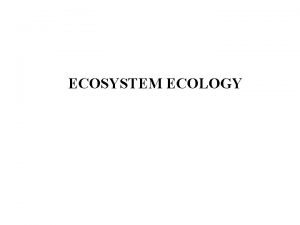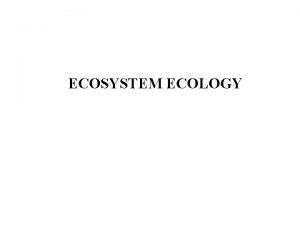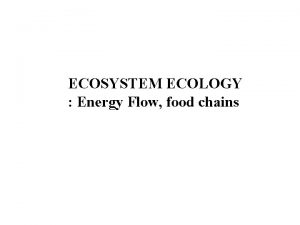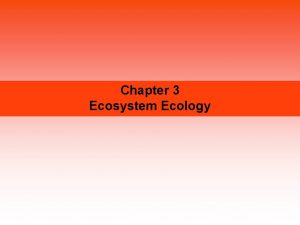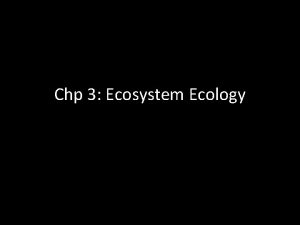Marine Ecology May 19 2008 EpipelagicAntarctic Marine Ecosystem

















































- Slides: 49

Marine Ecology, May 19, 2008 Epipelagic/Antarctic Marine Ecosystem, Part 1

The epipelagic zone n Epipelagic Ø Upper pelagic, within photic zone n Neritic Ø Waters on the continental shelves n Oceanic Ø Waters beyond the shelf break

Epipelagic food web(simplified)

“Classic” food chain vs. microbial loop

Phytoplankton types 1 n Free-floating photosynthetic Bacteria and Archaea Cyanobacteria Photosynthetic Archaea

Phytoplankton types 2 n Photosynthetic Protista Diatoms: have silicaceous “frustules”; many form chains Prymnesiophytes (i. e. Phaeocsytis) exist as single cells or colonies Dinoflagellates have two flagella Cryptophytes are single and small

Global primary productivity: marine

Factors affecting phytoplankton growth n n n Light Nutrients Location of the pycnocline Temperature Role of ice in polar regions

Light levels as a function of latitude

Nutrients (inorganic) n Nutrient sources ØUpwelling: n coastal and equatorial; n Edges of islands and reefs ØDeep mixing by winter storms n Examples: Key in Pacific Northwest, Antarctica ØRunoff from land n Example: In Antarctica, bird and seal colonies produce nutrient-rich waste

Nutrients n Nutrient sinks ØNutrients consumed by primary producers ØUneaten phytoplankton, consumers and their fecal material sink out of photic zone

Which is limiting, nutrients or light? (Very simplified…) n In Antarctic, ØLight-limited through much of year ØPossibly nutrientlimited later in the season… n Affects phytoplankton community composition

Pycnocline: location and stability n Shallow, stable pycnocline promotes phytoplankton growth

Pycnocline: location and stability

Temperate ocean (i. e. Oregon) *Shallow pycnocline: late spring through summer. Causes?

Polar ocean (i. e. Antarctica) *This shows open water. What about iceassociated areas?

Ice! n n Role in pycnocline set-up and stability Role in “seeding” ice edge blooms


Seasonal variation in ice cover (Parkinson et al. , 1998)

Variability in phytoplankton community composition n Both spatial and temporal variations. ØWhy? n Varying light levels n Varying nutrients n Presence in water column or ice ØExample: Phaeocystis vs. diatoms in Antarctic phytoplankton blooms

Zooplankton: overview n Key crustacean zooplankters Ø Copepods

Zooplankton: overview n Key crustacean zooplankters ØKrill!

Zooplankton: overview n Gelatinous zooplankters Salps (above) and larvaceans (below) both feed on picoplankton and nanoplankton Ctenophores are predators of other zooplankters

Beware of Beröe! n Feeds on other ctenophores; appears to reduce their negative impacts!

Antarctic marine food web (simplified)


Focus on krill! n n n Basic anatomical features Feeding behavior Food selectivity (briefly) Ø Primarily herbivores; feed preferentially on diatoms compared to Phaeocystis! Ø Winter omnivory? n n Schooling Life History

Life history basics Nauplius

Furcilia and juveniles (mostly) feeding beneath the ice

Declining krill? Or not…? (Angus Atkinson, 2004, Science)

Focus: Antarctic penguins Gentoo penguins (Photo: B. Grunewald) Chinstrap penguin (Photo: Shir Goldberg Adelie penguins (Photo: K. Haberman)

Adaptations for swimming, diving, cold water & snow n n Solid bones Hindlimb Ø Rearward rotation Ø Webbed feet Ø Claws n Forelimbs Ø Modified as paddles n n Air sacs: reduced Other…


Shift in penguin species on the Antarctic Peninsula

Black-browed albatross n Feeds primarily on krill! Black-browed albatross Photo: K. Haberman

Southern giant petrel n n Feeds primarily on krill “Gack” defense by young Southern giant petrel Photo: K. Haberman

Wilson’s storm petrel n “Jesus birds”: feed on near-surface zooplankton (smaller krill species, copepods, amphipods) Wilson’s storm petrel Photo: K. Haberman

Blue-eyed shag (cormorants) n n Feed on fish and squid; deep divers Have heavy bones like penguins Blue-eyed shag Photos: K. Haberman

Kelp gulls n Limpet eaters! Kelp gulls Photo: K Haberman

Order Pinnipedia, Family Phocidae Crabeater seal Photo: Karen Haberman

Crabeater seal skull showing krill eater teeth!

Elephant seals

Order Pinnipedia, Family Phocidae Leopard seal Photo: Karen Haberman

Order Pinnipedia, Family Phocidae Weddell seal Photo: Karen Haberman

Order Pinnipedia, Family Otariidae Southern fur seal (related to sea lions) Photo: Karen Haberman

Order Cetacea; Suborder Mysticeti Humpback Whale Photo: K. Haberman

Order Cetacea; Suborder Mysticeti Minke Whale Photo: Project Atlantis

Order Cetacea; Suborder Mysticeti Blue Whale Photo: Project Atlantis

Order Cetacea; Suborder Odontoceti Family Delphinidae Orca Photo: NOAA
 2008 2008
2008 2008 Ecosystem ecology
Ecosystem ecology Ecology ecosystem
Ecology ecosystem Ecosystem ecology
Ecosystem ecology Principles of ecology 2 flow of energy in an ecosystem
Principles of ecology 2 flow of energy in an ecosystem Ecosystem ecology
Ecosystem ecology Ecology terms
Ecology terms Ecosystem ecology
Ecosystem ecology Difference between ecosystem and ecology
Difference between ecosystem and ecology Difference between ecosystem and ecology
Difference between ecosystem and ecology Ecosystem ecology
Ecosystem ecology An ecosystem consists of
An ecosystem consists of Chapter 52 an introduction to ecology and the biosphere
Chapter 52 an introduction to ecology and the biosphere Marine ecology
Marine ecology Marine geospatial ecology tools
Marine geospatial ecology tools Marine geospatial ecology tools
Marine geospatial ecology tools Environmental resistance factors
Environmental resistance factors Magnesium cycle in marine ecosystem
Magnesium cycle in marine ecosystem Aquatic ecosystems webquest
Aquatic ecosystems webquest Marine ecosystem dominated by marsh grasses
Marine ecosystem dominated by marsh grasses Caribbean large marine ecosystem
Caribbean large marine ecosystem Characteristics of marine ecosystem
Characteristics of marine ecosystem Biotic and abiotic components of marine ecosystem
Biotic and abiotic components of marine ecosystem Which marine ecosystem contains the fewest producers
Which marine ecosystem contains the fewest producers 12th may 2008
12th may 2008 Hci design patterns
Hci design patterns Four levels of ecology
Four levels of ecology Yale industrial ecology
Yale industrial ecology Population ecology section 1 population dynamics answer key
Population ecology section 1 population dynamics answer key Ecology
Ecology Kinesis ecology
Kinesis ecology Genetics jeopardy
Genetics jeopardy Ernst haeckel ecology
Ernst haeckel ecology Which phrase best describes humidity
Which phrase best describes humidity Population characteristics ecology
Population characteristics ecology Ecology key terms
Ecology key terms Taxis in animals
Taxis in animals Ecology auto parts tijuana
Ecology auto parts tijuana Levels of organization in ecosystem
Levels of organization in ecosystem Biotic potential
Biotic potential Study guide section 1 population dynamics
Study guide section 1 population dynamics Gendina
Gendina Principles of ecology chapter 2 section 1 answer key
Principles of ecology chapter 2 section 1 answer key Which statement best describes nelson mandela?
Which statement best describes nelson mandela? Chapter 36 population ecology
Chapter 36 population ecology What is ecoology
What is ecoology Lesson 1 introduction to ecology answer key
Lesson 1 introduction to ecology answer key Chapter 1 science and the environment
Chapter 1 science and the environment Population ecology
Population ecology Chapter 56 conservation biology and restoration ecology
Chapter 56 conservation biology and restoration ecology

